|
Poly Plug & Tasks
 |
Poly Plug can be used to create whole class investigations which explore the iceberg of many tasks from the Mathematics Task Centre. Doing so allows teachers to model how to work like a mathematician. Tasks which can be converted in this way are listed below. In several activities students can record their explorations with these sheets:
If a task has a Task Cameo, it has been linked below. The Task Cameo will also tell you if the task has a companion Maths300 lesson.
Information about ordering Poly Plug can be found here.
|
|

Converting Task 62, 4 & 20 Blackbirds, to a whole class investigation.
Kingsley Park Primary School, Victoria
|

 |
Click the photo to enlarge it. |
Evidence shows that all students can learn to work like mathematicians in:
- mixed ability
- inclusive
- multiple intelligence
classrooms. Through professional development teachers become aware of Principles which guide the selection and use of tasks. One of these is that a task has three lives. The three lives are:
- as a small group investigation, usually two students
- as a whole class investigation
- as a personal investigation guided by a teacher-prepared sheet
Teachers also learn that success happens for students in a Working Mathematically Curriculum which balances:
- the invitation to work like a mathematician, as when choosing a task
- modelling how a mathematician works, as with whole class investigations
- toolbox lessons that develop and practise the skills of a mathematician - something which seemed to be the total purpose of traditional curriculum
All three aspects are important. Finding the balance is the essence of building a curriculum through which students, at all levels, learn that they can do mathematics because they can work like a mathematician.

More Poly Plug activities can be found in the Free Tour section of Calculating Changes. Click this logo.
|
 |
Investigating Tasks with Poly Plug
Poly Plug can be used to explore each of the tasks below as a whole class investigation. Ideas for doing so can be found in each link. Additionally, with Poly Plug as the 'main ingredient' these investigations can be grouped into menus linked by content as shown. You can create your own menus in this way, or use Café Conundrum Menu Maths Packs which have been prepared for you using these groupings. Units of work can be easily constructed around the Menu Maths Packs and the whole class investigations that grow from them.
Poly Plug Puzzles A
Computation, Pattern, Generalisation, Algebra
Year Levels: 3 - 8
- Task 5, Make A Snake
- Task 11, Lining Up
- Task 59, 13 Away
- Task 154, 4 Arm Shapes
- Task 173, Crossing The River 1
- Task 182, Jumping Kangaroos
Poly Plug Puzzles B
Logic, Reasoning
Year Levels: 3 - 8
- Big Toe Os & Xs
- Back To Back Building
- Crossing The Desert
- Nim
- Human Moves Monster
Poly Plug Puzzles C
Chance, Data, Computation
Year Levels: 3 - 10
- Counter Escape
- The Frog Pond
- Dice Differences
- Have A Hexagon
- 12 Counters
- Walk The Plank
Poly Plug Puzzles D
Number, Computation, Pattern
Year Levels: 3 - 8
- Row Points
- Cookie Count
- Eric The Sheep
- 4 & 20 Blackbirds (Red Birds)
- Bob's Buttons
Make Your Own Menus
- Task 2, Cars In A Garage
- Task 21, Tactical
- Task 22, Make Four Game
- Task 23, Two Colours Game
- Task 27, Can Stack
- Task 28, Plate Triangles
- Task 38, The Mushroom Hunt
- Task 49, Take A Chance
- Task 51, Staircase
- Task 52, Which Floor?
- Task 82, Snail Trail
- Task 95, Reflections
- Task 106, Crossing The River 2
- Task 111, Square Numbers
- Task 114, Where Is The Rectangle?
- Task 130, Protons & Anti-Protons
- Task 132, Red To Blue
- Task 139, Squound
- Task 140, Time For Tiling
- Task 145, Land Of ET
- Task 147, Garden Beds
- Task 151, Knight Swap
- Task 201, Rectangle Fractions
- Task 211, Soft Drink Crates
- Task 212, Monkeys & Bananas
- Task 230, Pack Up Your Bears
- Task 235, Tables For 25
- Task 236, Star Numbers
|

Equipment
- One red and two yellow/blue plugs per person
Problem
This task relates to Professor Morris Puzzles 27 & 28. The problem is that three cars of different colours park in three adjacent garages.
- How many ways can this be done?
- How do you know when you have found them all?
|

Visit the Task Cameo for
Cars In A Garage |
Procedure
- Use masking tape or an alternative to mark out three garages large enough to take a child. Another approach is to put three chairs at the front of the room and call them garages.
- Use large pictures of three different coloured cars. It is probably less distracting to use the same car coloured in three ways, and this can easily be produced with computer clip art and a colour printer. Choose three students to 'become' the cars and 'park' in the garages.
- Explore some of the ways they could 'park' and ask the class how these could be recorded.
- Ask for predictions of how many ways there would be altogether. Discuss.
- Ask the students to quickly draw three garages in a line. Provide the three plugs above. Students now have a red 'car', a blue 'car' and a yellow 'car'.
Note: It is preferable for each student (or pair of students) to have three (and more) small model cars to use, but this may not be practical, thus the Poly Plug alternative.
- Students explore and record the possibilities.
- Class discussion to record an agreed result.
- What do you think would be the number of ways if there were four cars and four garages?
- Develop a class wall story report on the problem as a model and ask students to complete their own version of it.

Equipment
- One Poly Plug set per pair
- Sheets of Poly Plug Paper for the teacher which have several blank boards on each sheet.
Problem
This task is a game and the problem is to decide the best strategy to win.
|
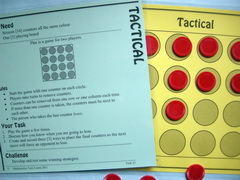
Visit the Task Cameo for
Tactical |
Procedure
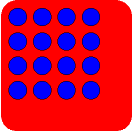
- Prepare a red board so that it shows a 4 x 4 set of empty spaces. Fill the spaces with either yellow or blue plugs.
- Place it in the middle of a student circle or gather the students at a central demonstration table.
- Invite two students to play the game according to the following rules.
- Players take turns to remove plugs.
- Plugs can be removed from either one row or one column each time.
- On each turn players can remove any number of plugs from a chosen row or column, provided the plugs are next to each other.
- The person who has to take the last counter loses.
- Invite pairs to play the game several times.
- Hold a class discussion about winning strategies. Record suggestions.
- Over time invite students to play the game and continue to refine the strategies.
- As the students play, sometimes record partially played games on your Poly Plug Paper. Make a display, or offer them to students in other ways with the challenge:
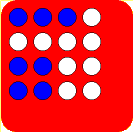
If it was your turn to move now,
what would you do and why?

Equipment
- One Poly Plug set per pair
- Sheets of Poly Plug Paper for the teacher which have several blank boards on each sheet.
Problem
This task is a game and the problem is to decide the best strategy to win.
Procedure
- Prepare a red board so that it shows a 4 x 4 set of empty spaces. You will also need 4 yellow plugs and 4 blue plugs.
- Place the board in the middle of a student circle or gather the students at a central demonstration table.
- Invite two students to play the game according to the following rules. One player uses yellow and one uses blue.
- Players take turns to put plugs into the board until all 8 plugs are placed in the sixteen gaps.
- When all plugs are placed, take turns to move them one space at time parallel to the sides of the board.
- The aim is to make four of your colour as a row, column or square.
- Invite pairs to play the game several times.
- Hold a class discussion about winning strategies. Record suggestions.
- Over time invite students to play the game and continue to refine the strategies.
- As the students play, sometimes record partially played games on your Poly Plug Paper. Make a display, or offer them to students in other ways with the challenge:
If it was your turn to move now, what would you do and why?

Equipment
- One Poly Plug set per pair
Problem
This task is a game and the problem is to explore strategies which force the other player to lose.
|

Visit the Task Cameo for
Two Colours Game |
Procedure
- Prepare a red board so that it shows a 5 x 5 set of empty spaces. You will also need all the yellow/blue plugs.
- Place the board in the middle of a student circle or gather the students at a central demonstration table.
- Invite two students to play the game according to the following rules. One player uses yellow and one uses blue.
- Players take turns to put plugs into the board one at a time.
- Plugs next to each other horizontally or vertically must be different colours.
- The first player who cannot place a plug is the loser.
- Invite pairs to play the game several times.
- Hold a class discussion about strategies that could force the opponent to lose. Suggest that it is better to consider you are playing against the 'world's best' because then any winning strategy would work on any player, and would not depend on the other player making a mistake. Record suggestions.
- Over time invite students to play the game and continue to refine the strategies.
- Make a class display of the developing insights about the game. Perhaps organise a premiership play off between interested class members.

Equipment
- One Poly Plug set per pair
Problem
Given a starting placement of cans stacked in a supermarket aisle predict the number of cans in the next layer and the number of cans needed altogether to make the stack.
|
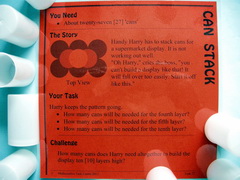
Visit the Task Cameo for
Can Stack |
Procedure
- You may need to allow students to freely stack the yellow/blue counters first before focusing on the problem - a free play time.
- Introduce the story shell of stacking cans in a supermarket display. All the cans have to be up the same way, so encourage using blue on the bottom. Suggest a starting stack such as:
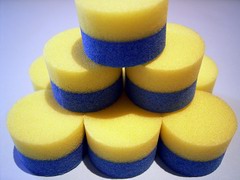
Top View |

Side View |
- Discuss how the next layer would be formed. There may be more than one way.
- For an agreed continuation of the stacking pattern, invite students to work out the number of cans in the next layer and the total number of cans needed to make the whole stack so far.
- Develop the problem further by asking students to work out these two numbers for the tenth layer. Discuss and record the various methods the students use to solve this problem.
- Some may be willing to tackle the general question, ie:
If I tell you any number of layers, can you tell me how many cans in the layer and how many cans altogether to make a stack with that number of layers?

Equipment
- Two Poly Plug sets for each group of 4
- One set of counters numbered 1-36 for each group of 4
|

Visit the Task Cameo for
Plate Triangles |

|
Problem
Arrange the plugs to make an equilateral triangle.
- How many plugs are added to make each new row?
- If I tell you any number of rows can you tell me how many plugs you need in total?
- If I tell you the number of plugs I have can you tell me the size of the largest equilateral triangle I could make?
Later, place the numbered counters on the plugs, in order from the top, and explore number patterns.
|
Procedure
- Begin the lesson as suggested in the Task Cameo using paper plates on the floor to make a large model.
- As the triangle builds, explore the connection between the Natural Numbers and the Triangle Numbers.
- Ask the students (in groups of 4) to reconstruct the triangle on their tables using the plugs.
- Suggest that the real challenge is to find the total number of plugs for any size triangle. Allow time to explore this problem then share the various approaches, successful or not.
- Suggest that Greek mathematicians saw mathematics as pictures rather than numerals, hence sets of numbers like Square and Triangle. Remind students that Greek mathematicians taught us that it is easy to count numbers arranged in equal rows which make a rectangle - Rectangle Numbers. Challenge them to see if they can picture a solution to the triangle counting problem using the plugs. Two possible approaches are shown below.
| Making A Parallelogram


This will work for any size triangle.
So twice the total is the longest side
times the longest side plus 1.
If N = the longest side, then
2T = N x (N + 1)
T = [N x (N + 1)]/2 |
Making A Rhombus

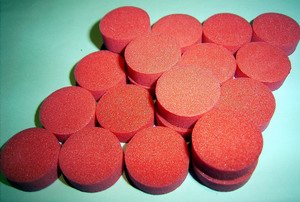
This will work for any size triangle.
So twice the total is the square of the longest
side plus the longest side.
If N = the longest side, then
2T = N2 + N
T = [N2 + N]/2 |
Two different answers and they are both correct? How can that be?
One More
| This approach was suggested by Julie Riga, Maryborough Education Centre. Look at the triangle one size less and reflect it across the diagonal. The two triangles will form a parallelogram which is (N - 1) rows of N.
This will work for any size triangle.
So the total is half this parallelogram plus the diagonal.
If N = the longest side, then
T = (N - 1)N/2 + N |

|
And now we have three equivalent algebraic expressions for the same total!

Equipment
- Two Poly Plug sets per four students
- Six paper plates, or margarine containers per four students
Problem
Six people go mushrooming. They have a basket each. When they return home each person counts the mushrooms in their basket. They realise that these six numbers are very special.
- If they total the six numbers the answer is 63.
AND
- If they can combine the numbers in different ways they can make every number from 1 up to 63.
|

Visit the Task Cameo for
The Mushroom Hunt |
What were the numbers of mushrooms in the baskets when the six people came home?
Procedure
- Introduce the problem and using a sample set of equipment try a case that doesn't satisfy both conditions. Two sets of Poly Plug provides 100 plugs, so, as part of the demonstration ask:
What is the largest number of plugs that I would have to press out of the boards?
- Ask the students to explore the problem and keep a record of the arrangements they try and (if possible) why they chose each possible arrangement.
- When the solution has been found, ask the solvers to try to explain how they arrived at it. Their notes should assist this explanation.
- Suppose there was one less basket, but the structure of the problem was the same. What would be the new total number and what would be the basket numbers?
- Suppose there was one more basket, but the structure of the problem was the same. What would be the new total number and what would be the basket numbers?

Equipment
- One Poly Plug set for each student
- One deck of cards - a large size deck works well
Problem
In this game the deck is shuffled and the top two cards are turned up as the 'ends'. Players risk 1, 2 or 3 counters (or pass) on whether the next card will fall between the ends. Players start with 10 red plugs out of their board.
|

Visit the Task Cameo for
Take A Chance |
 |
- If they win they get back the plugs they risked and take the same number again from the board.
- If they lose they put the risked red plugs back in the board.
- The game ends when one pair has 20 plugs out of the board and wins, or one pair puts all their plugs back in the board and loses.
The challenge is to decide the best strategy for risking counters on each play.
NB: All cards are returned to the deck and it is reshuffled after each play.
Procedure
- Teacher shuffles and places the ends.
- Groups decide what to risk and place their risked plugs in the centre of the table.
- Teacher turns the next card. (Class groans or cheers appropriately.)
- Pairs take plugs from, or put plugs into, their board.
- Repeat 1 - 4 until one pair wins or loses.
|
At this point each group must leave its current plug supply in the middle of the table so that class data can be collected as in the photograph. In this class there were 10 pairs. Each began the game with 10 red plugs. That's a class stake of 100 plugs. If the class had done well, they would have more than 100 plugs when the game finished.
This class has not done so well, but this begs the question 'Have we been making the best risk decisions?' Exploring the chances of a win for each possible 'ends' situation should lead the class to making better decisions. After each pause in the lesson to discuss strategy, play the game again to see if the class is doing better.
To explore a situation, consider, for example, 3 and 9 as the ends. This is a situation with 5 cards between (4, 5, 6, 7, 8) which could produce a win. But there are four of each in the pack, so 20 possible winning cards of the 50 cards left in the deck. A 2 out of 5 chance of winning. Should we risk any counters? Investigate all the possible 'betweens' in a similar way. Perhaps the investigations can be shared among the pairs of students.

Equipment
- One Poly Plug set per pair
Problem
Calculate the number of plugs needed to build a staircase of any height.
|
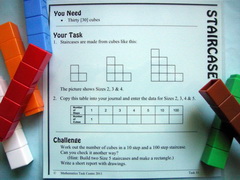
Visit the Task Cameo for
Staircase |
Procedure
- Ask students to build a staircase as shown as far as is possible with one red board.
- The challenge for today is:
If I tell you any number for the highest step in the staircase, can you tell me how many plugs there would be altogether?
- This is not an easy task. Encourage visual ways of working. For example, in this photo:
- the central column of plugs is three high
- the columns to its right are, respectively, one and two plugs higher
- the columns to its left are, respectively, one and two plugs lower
- shifting the excess plugs from the right to the left would make five columns, each three plugs high, so a total of 15.
- Explore What happens if ...? questions such as:
- there are an even number of columns in the photo?
- the staircase rises two for each column it moves across?
- the staircases rises to the highest then comes back down in the same pattern, creating a double staircase?
|

|

Equipment
- Two Poly Plug sets per pair or group of 4
Problem
We know the journey someone took in an elevator - how many floors up and how many floors down. We know the floor they came out of the elevator. The challenge is to work out the floor (or floors) where they began.
|
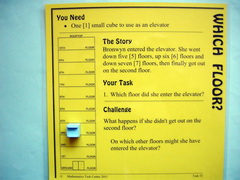
Visit the Task Cameo for
Which Floor? |
Procedure
| This is a great activity to begin as a physical involvement situation outside, or in an appropriate inside space. The picture on the right is the table top version of the problem, but it can readily be adapted to a whole-body scale using a set of number cards from 0 - 9.
A problem to begin the investigation is:
Andrew gets into an elevator. He goes
- down 2 floors
- up 4 floor
- down 3 floors
He gets out at the 2nd floor.
Which floor did he enter the lift?
Students will tackle this initial problem either by guess and check, or, perhaps with a little encouragement, by working backwards. One of the main thrusts of the problem is indeed to introduce, or refresh, working backwards as a problem solving strategy.
|
 |
|
After appropriate practice with this level of problem - physically, on the table top with Poly Plug, and creating their own challenges for each other - the challenge level can be increased with questions like:
If Andrew does the same journey, but doesn't get out at Level 2, what other floors could he enter the lift?
This challenge begs the mathematician's questions:
- How many solutions are there?
- How do you know when you have found them all?
 |
The next level of development comes from realising what can be changed in the problem and asking What happens if...?.
The journey can be changed. The number of steps in the journey can be changed. The exit floor can be changed. The height of the building can be changed.
...and...
What happens if there are twin elevators and Andrew and Angela enter at different floors, make different journeys but both step out at the same floor? |
 |

Equipment
- Three Poly Plug sets per group of 4
Problem
A snail starts at the bottom of an 11 metre well and climbs 5 metres in one hour. Then it rests for one hour during which it slips back 3 metres. If this climbing resting pattern continues, how long will it take the snail to climb out of the well?
|

Visit the Task Cameo for
Snail Trail |
Procedure
| This is a great activity to begin as a physical involvement situation outside, or in an appropriate inside space. The picture on the right is the table top version of the problem, but it can readily be adapted to a whole-body involvement by stepping out and marking the asphalt with chalk.
A opening problem is as above:
- 11 metre well
- crawl up 5m in one hour
- slide back 3m while resting for one hour
- climbing and resting pattern continues
When will the snail get out of the well?
After exploring this problem in teams outside, return to the classroom so each team can set up the Poly Plug version on their table. Check the outside work with this model, then discuss the variables in the problem. What can be changed?
- height of the well
- up distance
- sliding back distance
- length of the time unit (eg: half hour units instead of one hour)
- whether the snail crawls up or down
Students select one combination of alternatives and explore their own problem in groups. Facilitate a class discussion of the range of the results.
- Is there a way to tell if a chosen set of variables won't work?
|
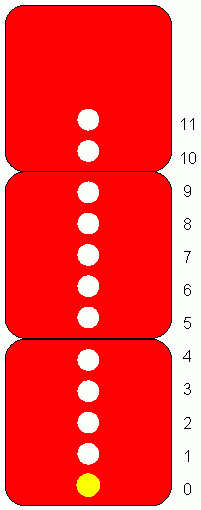 |
|

Equipment
- One Poly Plug set per pair
Problem
If I give you a reflection line (mirror) and a part of a picture, can you complete the picture so it is symmetric? Is there more than one way?
Procedure
To model the equivalent of this task, the plugs of a Poly Plug could be thought of as the nails of a 5 x 5 geoboard. But there is no need to join the 'nails' with rubber bands to see a symmetric pattern.
|
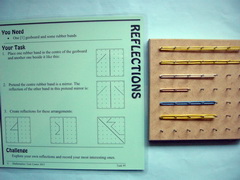
Visit the Task Cameo for
Reflections |
Start with an empty 5 x 5 red board and mark in a line of symmetry:
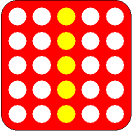 or or 
Player A plugs in blue (perhaps either side of the line of symmetry) and when finished, Player B has to plug blues into symmetric places.

|
Encourage students to record their creations on Poly Plug Paper.
- What happens if Player A inverts a plug in the line of symmetry?
- What happens if players use two board or four boards?
These ideas of symmetry are reinforced and extended by a collection of activities on Exploring Symmetry with Poly Plug created by teachers from Mayfield, Rocherlea and Kingston Primary Schools for Calculating Changes. |

Equipment
- One Poly Plug set per group of 4
Problem
Three adults and three children have to cross a river in a row boat. Their situation is:
- The boat can only take two people.
- All the adults can row but only one of the children can row.
- At no stage is there allowed to be more children than adults.
|

Visit the Task Cameo for
Crossing The River 2 |
Procedure
This is a great problem to begin by acting out - perhaps sleeves down/sleeves up = adults/children and the rowing child has a yellow paper hat saying Rowing Champion. It doesn't matter whether or not the students solve the problem in this way. Either it will introduce the challenge so all understand what is involved, or, if solved, will provide the opportunity to challenge each pair to reproduce the class's solution.
Each pair can easily set up the problem on their table using blue plugs for the adults, yellow for the child rower and red for the other children. This is not a straightforward problem, so expect it to take some time, a few false solutions that don't obey Rule 3 and considerable discussion. Use the problem to highlight the work of a mathematician, in particular, the strategies of 'make a model' and 'try every possible case'.
Once all are confident with the solution, shift the emphasis to that part of a mathematician's work that involves recording, explaining to others and publishing. Students might record in their journal, instruct someone else in the solution while keeping their hands behind their back, or publish a poster, comic strip, PowerPoint or video for others to understand the solution. The video could perhaps be presented as a news report.
One solution and extensions to the lesson are described in the Task Cameo.

Equipment
- One Poly Plug set for each student
Problem
Take all the plugs out of a red board. Start with one yellow plug in the corner. Build up a pattern of L-Shapes like this:

Wherever there is a visual pattern, there is always a number pattern.
What number patterns can you discover?
|

Visit the Task Cameo for
Square Numbers
|
Procedure
- Introduce the problem and invite students to explore it.
- Discuss what has been discovered and make a class recording.
- For any of the discoveries ask: Can you check it another way?
- Encourage students to work together to explore how the pattern grows to 10 Ls.
- If I tell you any number of Ls what can you tell me about ... the yellow plugs? ... the blue plugs? ... the total of the plugs?

Equipment
Problem
To identify the position of the four (or sometimes two) corner plugs of the hidden rectangle in the least number of guesses.
Procedure
- Start with a completely blue board. Turn over any number of blue plugs to make equal rows in a board and show it to the students, eg:
|

Visit the Task Cameo for
Where Is The Rectangle? |
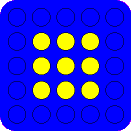 ...or... ...or...  ...or... ...or... 
- Point to the plug in the bottom left corner.
If we say this plug is at zero this direction (indicate horizontal) and zero this direction (indicate vertical), what is the position of this plug (point to one of the yellow ones)?
- Explore the positions of other plugs using this ordered pair system.
- Introduce students to the two person game. The aim is to find the corner plugs, given the plugs are in equal rows.
(You might introduce this by having one student hide to make the equal rows in the plug board. You work with an overhead transparency of the Poly Plug Paper to deduce the corners.)
The rules of the game are:
- Player A secretly makes equal rows of plugs and tells Player B the total number of plugs turned over.
- Player B writes this total above the first picture on their Poly Plug Paper and guesses an ordered pair.
- Player A tells whether this plug is on the edge, inside or outside the rectangle of equal rows.
- Player B records this answer and continues guessing until the four (or in some cases two) corners can be identified by their co-ordinates.
Note: Player A must not turn their board around once the equal rows have been made.
Where Is The Rectangle? is a rich task. It can be visited frequently, and although the structure of the problem remains constant, the challenge in it changes with each different arrangement of equal rows. Consequently, once the students understand the structure, it can be threaded into the curriculum for a few minutes a day, two or three times a week over several weeks. Threading is a powerful curriculum model which allows genuine time for the students to construct their own learning. The students do not become bored with the activity and, in fact, find security in the familiar aspects of the challenge.
When students become proficient with the 5 x 5 board, use two boards to make 10 x 5 or 5 x 10, or four boards to make 10 x 10.
Note
The NRICH web site has a neat, software-based complement to this task which they call Poly Plug Rectangle. It offers several levels of challenge in the Teachers' Notes and video from classrooms.

I particularly like the model of integer arithmetic illustrated with this activity. It is true to pedagogical and mathematical principles:
- Pedagogical - proceed from the known to the unknown.
- Mathematical - the importance of the identity element in the number system.
Equipment
- One yellow/blue board for each pair
|

Visit the Task Cameo for
Protons & Anti-Protons |
Problem
An article in The Australian, July 5th 1995, page 7, confirms the
existence of anti-protons. Protons and Anti-protons have the same
mass but opposite charge, therefore when they meet they annihilate each other. So, a combination of equal numbers of each has a total effect of zero. (Let's not get too lost in the science here. The model is being introduced to help kids visualise operations on integers, which they sometimes find difficult. In scientific truth there is also a burst of energy in such a collision.)
The problem is to discover how these particles behave in collections.
Procedure
Following a kinaesthetic approach using the students classified
into two groups, and identified by colour bands from the sports
store, as model protons and anti-protons, the two sided Poly Plug
counters make a ready model of this situation.
First explore the many ways of making a collection with a
particular value (say 3P where the blue side means proton and the
yellow means anti-proton):
 etc. etc.
- representations worth 3 protons -
It is important to consolidate here and discuss the zero effect of
a proton/anti-proton pair. It is then a natural step to use the
materials to investigate situations such as:
3P + 2P ... 3P - 2P ... 3P + 2A ... 3P - 2A
It is the last of these which requires the fullest understanding
of the idea that a proton/anti-proton pair is worth zero. In order to
have two anti-protons to take away, they must first be added in as
part of two zero collections:

- total value is still 3P -
Now 2A can be taken away and the result will be 5P.
Again, after consolidation, the concept of protons and
anti-protons having opposite charge can be reintroduced. By precise
analogy the four exercises listed above become:
+3 + +2 = +5 ...
+3 - +2 = +1 ... +3 + -2
= +1 ... +3 - -2 = +5 !!!
The students have now essentially derived the rules for adding and
subtracting integers from their own experiments. Further
consolidation often means that rules are not necessary because the
students 'picture the operations in their heads'. Teachers also
frequently comment that it is surprising with this approach how those
normally classified as poor students in the chalk/talk/text approach
become quite confident with this approach; and, sometimes, those
normally classified as good students in the chalk/talk/text approach
become insecure.

Equipment
- One yellow/blue board per pair
Problem
The task becomes Yellow To Blue when using Poly Plug. Starting with 4 yellow plugs the objective is
to turn them over to be all blue in the least number of moves. The turning rule is:
Turn over all except one on any move.
|
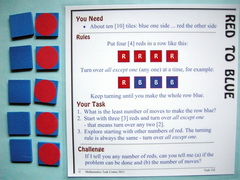
Visit the Task Cameo for
Red To Blue |
Procedure
- Pairs investigate the original problem.
- When they are confident with that, ask: What happens if we change the number of plugs?
- What happens if we change the turning over rule?

Equipment
- One red board per pair
- One piece of A4 paper
Problem
The playing board displays a square and a circle that overlap. Given a total number of plugs and the numbers in the square and circle, find out how many are in the Squound, which is the name given to the overlap region.
|
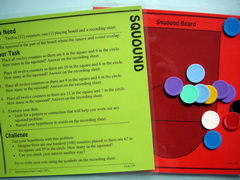
Visit the Task Cameo for
Squound |
Procedure
- Ask each pair to orient their A4 sheet to landscape and draw an approximate square as big as possible on the left end. Then overlap it with a circle as large as possible on the right end. Sketch what you want on the board or have an example prepared.
- Explain which region is the Squound.
- Ask each pair to select 12 red plugs and explain that for now, that is all they need.
- So you will always know that we are dealing with 12 plugs. Now I am going to give you some clues and for each one the objective is to tell me the number of plugs in the Squound
- Set a number of exercises such as 10 in the square and 9 in the circle, or 8 in the square and 4 in the circle. These can be given orally, or written on the board, or prepared as an investigation guide.
- Explain that the first challenge is to discover and explain a method for always being able to find the Squound number.
- Go on to explore other challenges as described in the Task Cameo, such as:
- What happens if we chose a different number of plugs, say 3, and ask how many squound problems can be created?
- What happens if we explore the number of squound problems that can be created for 0, 1, 2, 3, 4, 5, ... counters?

Equipment
- One Poly Plug set per pair
- Graph paper
Problem
Douglas is planning to build an outdoor play area for his grandchildren. It will have circular stepping stones arranged in equal rows with a diagonal pattern of contrasting stones. The spaces will be filled with white sand or pebbles. He thinks his grandchildren will make up lots of games to play in an area like this.
 or or 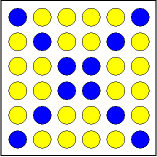 or ... or ...
The problem is to help Douglas know how many blue and how many yellow stones to buy for any size square area.
|
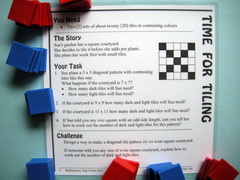
Visit the Task Cameo for
Time For Tiling
|
Procedure
- Gather the students at a central table and explain the story shell as one pair of students helps to build an example (say 5 x 5).
- Pose the problem and ask students to work as pairs or as small groups to explore some different sizes.
- Gather the data on the whiteboard (students can write their own results and ask students to record it in their journals in an organised way.
- Look for patterns in the table of results and use them to predict blue and yellow for other size squares.
- The question, Can we check this another way?, can be used to encourage seeking a visual understanding to match the number pattern, as described in the cameo.
- Follow on with the other ideas in the iceberg information in the cameo.
- At the end of the investigation by asking students to reflect on how the class has worked like a mathematician. Use the Working Mathematically Process as a guide.
Extension
- Write a letter to Douglas (or prepare a poster or slide show) to advise which size play area he should build and explain how you know the number of blue and yellow tiles he should buy. Suggest at least three games his grandchildren might play on the stepping stones in this area.

Equipment
- One yellow/blue board per pair
Problem
The King and Queen of the Land of ET are sick of their language. There are only two letters, B and Y, in the language and that means words just get longer and longer. Here are some examples:
BBY and BYBY and BBBYYBBB and BBYBBYBYYYBY
To make things easier, the Royals made new rules:
- BBB next to each other is removed (or included)
- YY next to each other is removed (or included)
- BYB next to each other is replaced by Y
- Y can be replaced by BYB
|

Visit the Task Cameo for
Land of ET |
| Example 1

So the word BBYBYBBY has become the word Y.
|
Example 2

So the word BBY has become the word YB.
|
Using the King and Queen's rules, which words remain in the language of ET?
Procedure
- Make up words of any length and apply the Royal Rules. Record the new words you make each time.
- Including the 'nothing word', how many words are there in the new language of ET?
- When you have found all the new words, choose any two and add them together. What happens?
- Explore and record all the possible ways of adding any new word to any other new word. What happens?

Equipment
- One Poly Plug set per pair
Problem
A garden plants a line of beautiful yellow stem plants with blue flowers.
She also places stepping stones around the line like this:

If I tell you the number of plants can you tell me the number of tiles?
|
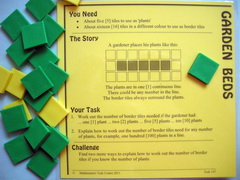
Visit the Task Cameo for
Garden Beds |
Procedure
- Allow pairs to work on the problem.
- Discuss and record how students work it out. This is an example of visual algebra. The recording can be in words and the words can then be converted to a mathematical sentence, or equation.
- Ask: Can you check this another way? and encourage 'seeing' the arrangement in alternative ways. An example would be as a 3 row array from which the number of plants is subtracted to reveal the number of stones. Discuss other suggestions.
- Ask the working backwards question: If I tell you the number of stones can you tell me the number of plants?
- For a selection of path lengths, build up a table of values on the whiteboard. It is important that these are not in order because data does not come to a mathematician pre-ordered. Part of the work is to find a way to order the data in the hope of making sense of it.
- Each row of the table of values is an ordered pair and ordered pairs can be graphed. Plot the ordered pairs. What happens? How does this picture relate to the problem?
- What happens if there are multiple rows of garden bed surrounded by one 'envelope' of stones in the same way?

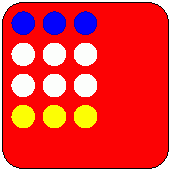 Procedure
- Encourage pairs to work on the problem.
- When a solution is found, encourage the finders to keep it to themselves and try to record it in their journal. This could be as a sequence of drawings or in symbols to interpret the place of the knights on the 2D grid.
- Extend the challenge by asking: What happens if we use a 4 x 3 grid and start with three knights on the top and bottom?.

Equipment
Problem
From a spatial perspective every rectangle has three parts:
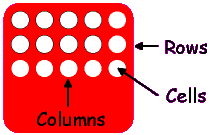 In this case the rectangle can be used to show thirds (rows), fifths (columns) and fifteenths (cells).
In this case the rectangle can be used to show thirds (rows), fifths (columns) and fifteenths (cells).
|
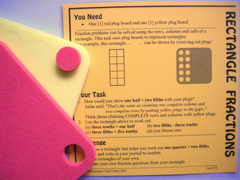
Visit the Task Cameo for
Rectangle Fractions |
The challenge is to become more efficient at making any whole rectangle by 'unplugging' the red board and exploring the fractions it illustrates by plugging in yellow and blue plugs. For example:
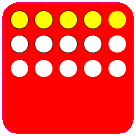 
Plugging one third yellow and plugging two fifths blue.
Procedure
- Use a demonstration Poly Plug rectangle as above to talk about the physical/spatial parts - rows, columns and cells - of the whole.
- Change the whole and go through the same discussion again.
- Ask students to record the main points of the discussion in word and picture on Poly Plug Paper.
Rectangle Fractions is a rich task. It can be visited frequently, and although the structure of the problem remains constant, the challenge in it changes with each different whole rectangle. Consequently, once the students understand the structure, it can be threaded into the curriculum for a few minutes a day, two or three times a week over several weeks. Threading is a powerful curriculum model which allows genuine time for the students to construct their own learning. The students do not become bored with the activity and, in fact, find security in the familiar aspects of the challenge. (See Threading in Calculating Changes In Brief.)
In particular, where fractions are concerned, the longer students have been exposed to fractions largely through symbolic manipulation with little reference to materials, the more there is a tendency to see the topic as meaningless, and the longer threading may need to continue. The emphasis throughout is that the spatial/geometric representation of rows, columns and cells is the solution to any question.
- Ask students to work backwards: What rectangle would you choose that could show halves and thirds? ... eighths and halves? ... Answers can be described in words or drawn.
- When students appear confident with spatial representation, introduce the idea of showing two different fractions on the same whole. For example, showing one third and two fifths on the same whole requires thinking like this:
Showing one third means plugging one row...

|
 |
Showing two fifths as well means plugging two columns...

|
| But where will the two blue plugs go when the yellow ones are already in their spaces?
Simple. Shift them somewhere else that is empty...
|
 |
... then the blue plugs still show an amount that is the same as two fifths.
|
- In this way students can be helped to find a visual representation for the addition of fractions. In this case, it is clear that:
1 third + 2 fifths = 11 fifteenths
- Eventually encourage students to picture in their mind, rather than actually make, the whole rectangle that would be needed to work out the addition of fractions given symbolically. Using graph paper to explore larger rectangles than 5 x 5 can be a bridge into this visualisation.

Equipment
Problem
A person was packing cans into a crate with spaces like this:
When 10 cans (yellow/blue plugs) were packed, it was noticed that:
EVERY row and column had an EVEN number of cans
How were the cans arranged? |
 |
Procedure
- Introduce the problem using a centrally placed Poly Plug arrangement as above. Pack a few cans and examine whether rows and columns have an even or odd number of cans. Emphasise that zero is an even number.
- Students investigate the problem in pairs. Is there more than one answer?
- What happens if we change the number of cans to, say, 18?
- Explore all numbers of cans. Which can be placed so that all rows and columns are even?
|
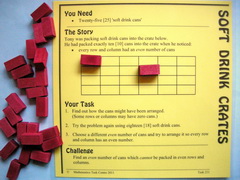
Visit the Task Cameo for
Soft Drink Crates |

Equipment
- One Poly Plug set per pair
Problem
A little twist of the story is necessary to investigate this problem with Poly Plug because they don't look much like bananas. Kids & Cup Cakes works well and a story shell something like:
|
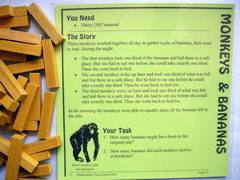
Visit the Task Cameo for
Monkeys & Bananas |
One morning Peter, Paul & Mary helped bake some cup cakes. They were so tired when they finished that they went to have a sleep.
- During nap time Peter woke up, snuck out to the kitchen, took one third of the cakes and hid them in a safe place. But he had to eat one of the cakes first before he could take exactly one third. Then he went back to bed.
- Later Paul woke up, snuck into the kitchen, ate one cake and took one one third of the cakes that were left and hid them in a safe place. Then he went back to bed.
- Finally Mary woke up, went to the kitchen, ate one cake and took one third of what was left and hid them before she went back to bed.
After nap time the three children were able to equally share all the cakes left in the kitchen.
- How many cakes might have been in the kitchen before nap time?
- How many did each child get at the sharing after their sleep?
Procedure
- Tell the story to introduce the problem. It is a complex story so it helps to have it backed up with a printed version for each group.
- Students investigate the problem in pairs with a view to contributing to a class 'journal' that develops on the board as things are tried out. Since many students use a 'Guess, Check & Improve' strategy, it is useful to keep a table of numbers that do/don't work for the original cake collection.
- Encourage identification of strategies that are being, or could be, used based on the Working Mathematically process. There are several ways to solve the problem, working backwards for example, but eventually the class will discover that 25 works for the original number of cakes and leads to a share of two cakes each after the nap.
- But is 25 the only possible solution? Share the work of finding more. Agree to either start with a number for the original pile or a number for the final share so all groups are 'working in tune'. This work does not have to be done all at once. Each group could take one number each day and the results could be recorded in the class 'journal'.
- Another approach, depending on the age, is to use a spreadsheet to do the testing. The problem involves a step by step set of mathematical actions that fit brilliantly with this tool. In fact, the problem might be used to introduce students to the spreadsheet tool. One way or another they will hopefully find the next solution, which is an original cake collection of 106, with a share number at the end of 10. The next solution after that is (187, 18) and if you get this far, a pattern begins to show up.
- What happens if the problem involved only two children who hid one half of the cakes after eating one each time? Or four children each of whom takes one fourth after eating 1? ...?

Equipment
- One (or two) Poly Plug sets per pair
- Student journal or other appropriate recording format
Problem
The task card shown sets the problem using six bears and trays for packing up that can take a minimum of zero bears and a maximum of 6 bears each. Those parameters can work using two Poly Plug red boards (as shown in the Whole Class Investigation section of the Cameo), but a slightly simpler beginning uses just one red board:
|

Visit the Task Cameo for
Pack Up Your Bears |
The children are playing with five 'pretend bears' (yellow/blue Poly Plug). Mother says its time to pack up. They have three trays (3 rows of a red board with the plugs removed) they can use for packing and each one takes up to five bears. Investigate and record the ways the bears could be packed up.
Procedure
- Ask students to push out 5 yellow/blue plugs then put the yellow/blue board back into the bag and also to take out the red board and remove all the plugs from the first, third and fifth rows and put them back in the bag too.
- Ulla and Sanya were pretending their yellow/blue plugs were teddies and made up a story about them. Have a play with yours for a minute or two. Perhaps you can make up a story about them too.
- When students are relaxed with the imaginary play situation tell the rest of the story.
Mother told Ulla and Sanya it was time to pack up and gave them three trays like the rows on your red board. Each row could have zero, or one, or two, or three, or four, or five teddies. As long as the teddies were somewhere in a tray, mother was happy. Now it's time to pack up your teddies too.
- Select the packing up arrangement from one pair of students and hold it up to show.
Did everyone pack up their bears like this?
It's most unlikely that everyone did choose the same way, so discuss how the different ways could be recorded. It might be by drawing or it might be by equation. For example:
1 + 3 + 1 = 5 would mean 1 bear in one row, three bears in another row and 1 bear in another row.
This might also be the right time to discuss what 'different' means in this case. For example how will the class agree to interpret these responses:
1 + 3 + 1 = 5 ... 1 + 1 + 3 = 5 ... 3 + 1 + 1 = 5 ... and other similar variations.
If the choice is that order matters, then there will be many more solutions to the investigation below. It will therefore be less complex if you guide students towards seeing all permutations as the same combination.
See, if we turn our red board around, it's still two 1s and a 3 OR Mum doesn't care how the bears are packed, as long as they are all in the trays. So all that really matters is that there are two trays with one bear and one tray with three bears.
- Once the 'ground rules' have been explored the investigation becomes finding and recording as many ways as possible of packing up the bears. For less experienced students this might be by a guess and check approach; for more experienced students it is appropriate to use an approach of breaking the problem into parts (Let's start by putting 5 bears in one tray. How many ways can we do it?) and trying every possible case. Overall the investigation is about a context for finding all the ways to sum to 5 with three whole numbers.
- Extensions include changing the number of bears, or the number of trays, or the number of bears that can be packed into each tray.
- Extensions also include designing backwards questions such as:
Make these trays ... [ ___ ] + 1 + 0 = 5 ... and work out the missing bears.
All these extensions are explored further in the cameo.

Equipment
- One Poly Plug set per pair or group of 4
- Pieces of A4 or A5 paper to use as tables
Problem
There are 25 students in the class today and 14 are boys. The teacher wants them to sit in groups of 5 with at least two boys in each group. How many ways could the students arrange themselves?
|
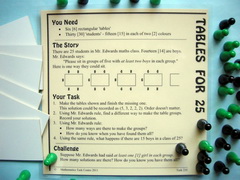
Visit the Task Cameo for
Tables For 25 |
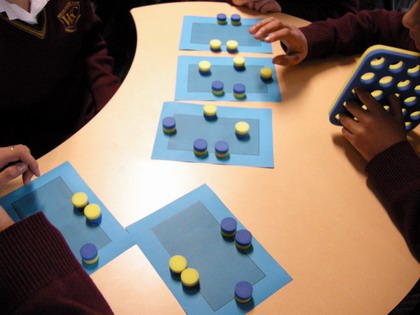 |
Procedure
- Set the context through a story shell about a colleague who had 25 students in the class and wanted them to sit in groups the same size. What sizes could he choose? Students soon see that 5 is the only realistic possibility.
- Well, on this day, there were 14 boys in the class, you can use your Poly Plug blue side up to show boys. Mr. Edwards said he wanted 5 students at a table and at least 2 boys in each group. How could the students arrange themselves?
- It soon becomes apparent that there is more than one solution, so the next step is to ask the mathematician's questions:
- How many solutions are there?
- How do we know when we have found them all?
- To work towards answering those questions, students have to realise that 'at least two boys' means 10 must be used around the 5 tables. There are only four left to 'play with'. The girls, in this case, don't matter.
|
- One way to solve the problem now is to examine every possible way to arrange these extra four boys around the tables. Remember the tables can't be distinguished, so order doesn't matter. Following this through, the possible arrangements for boys are: (5, 3, 2, 2, 2), (4, 4, 2, 2, 2), (4, 3, 3, 2, 2), (3, 3, 3, 3, 2).
- What happens if...?
- Mr. Edwards says there should be at least one girl at each table instead of at least two boys?
- We change the number of students in the class? What equal size groups are possible with the new number?
- We change the ratio of boys to girls?
- We change the seating restriction?
- Design and investigate your own Tables For... situation.

Equipment
- One Poly Plug set each or one per pair
Problem
If I show you how to construct one Star Number, say Size 4, can you tell me how many plugs I need to construct a Size 10 Star Number?
|
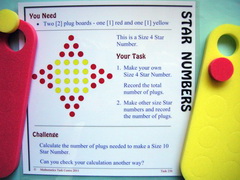
Visit the Task Cameo for
Star Numbers |
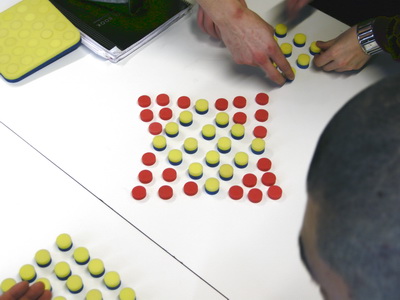
- Once this starting point question has been answered
100 + 4 (1 + 2 + 3 ... + 9) = ...
there are many others:
- How many plugs to make Star Number 20? 50? 100?
- If I tell you I have 1000 plugs, what it the largest Star Number I can make?
- Make pairs of numbers (Star Number Size, Number of Plugs). If you graph these pairs what do you expect to see? Graph the points to check your prediction.
- If I tell you any size Star Number can you tell me how many plugs I will need to make it?
- If I tell you any number of plugs can you tell me how to work out the largest Star Number I can make from them?
- Suppose I want to make a Christmas decoration that starts with Star Number 1 and shows all the Star Numbers up to 10. How many plugs will I need?
|
Procedure
- With student help, construct a Size 4 Star Number on a central table and pose the question.
- Students might choose to work it out by building the Size 10, which will take quite a deal of co-operation between groups, or they might decide to collect more data about Star Numbers, and organise it to see if a pattern develops.
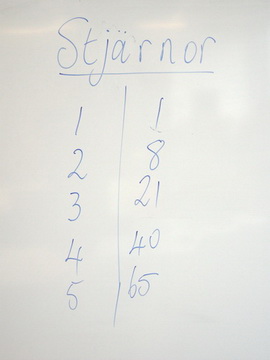
And for those who like a considerable algebraic challenge, derive a formula to find the number of plugs needed to create all the Star Numbers from 1 to n.
|

Mathematics Task Centre ... is a division of ... Mathematics Centre
|

 or
or 
 ...or...
...or...  ...or...
...or... 
 etc.
etc.













































 or
or  or ...
or ...


















